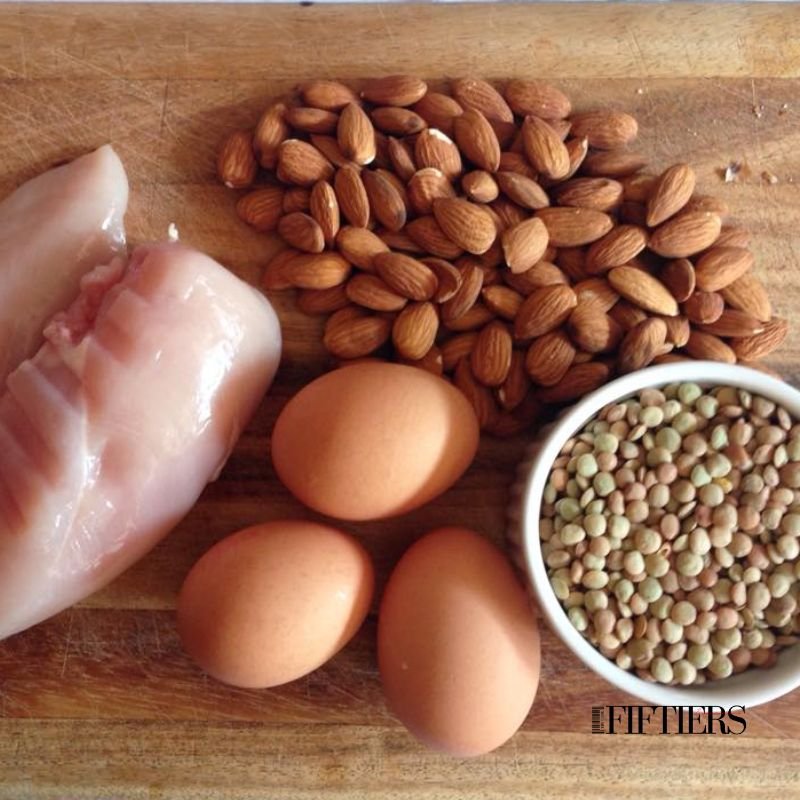Key Proteins for People Over 50: Essential for Muscle Mass and Where to Find Them in Food

FIFTIERS | Life Begins at 50. La vida comienza a…
From the age of 50, the human body begins to undergo structural changes associated with aging—most notably the progressive loss of muscle mass and strength, a condition known as sarcopenia. This phenomenon reduces mobility, increases the risk of falls and fractures, and severely impacts the quality of life in older adults. The decline in muscle tissue results from a combination of factors, including hormonal changes, decreased physical activity, chronic low-grade inflammation, and, critically, insufficient protein intake, which accelerates muscle degradation.
Skeletal muscle is essential not only for locomotion and posture but also for metabolic balance, immune competence, and overall physical autonomy. Therefore, preserving lean body mass in older age is fundamental to maintaining independence and global health.
A growing body of research has identified dietary protein as a central nutrient in combating sarcopenia and supporting muscle health in the aging population. Adequate protein intake enhances muscle protein synthesis (MPS), supports strength maintenance, and improves recovery after periods of immobility or injury.
Conversely, diets low in high-quality protein exacerbate muscle atrophy and functional decline. Moreover, consuming more than the minimal recommended levels of protein has been linked to broader health benefits in older adults: improved weight management, reduced visceral fat and waist circumference, enhanced glycemic control and lipid profiles, and increased satiety. Collectively, these outcomes contribute to healthier and more active aging.
This technical article explores the most important proteins and essential amino acids for preserving and developing muscle mass in individuals over 50 years old. We differentiate recommendations where relevant for men and women and include a detailed table of dietary sources, showing protein content, bioavailability, and completeness of amino acid profiles. All insights are backed by recent scientific evidence (2022 onward), drawn from leading journals such as The Journal of Nutrition, American Journal of Clinical Nutrition, Nutrients, and Frontiers in Nutrition.
Sarcopenia, Anabolic Resistance and Protein in Older Adults
Age-related sarcopenia is characterized by a gradual reduction in muscle protein synthesis (MPS) and a relative increase in protein degradation, resulting in a negative protein balance and muscle loss. A central phenomenon in this process is anabolic resistance: aged muscle shows a diminished anabolic response to stimuli that would typically trigger MPS, such as protein intake or resistance exercise, when compared to younger muscle tissue.
Practically speaking, this means that older adults require higher doses of dietary protein—especially rich in essential amino acids (EAAs)—to stimulate MPS at levels comparable to young adults.
One essential amino acid plays a particularly powerful role in overcoming anabolic resistance: leucine. Leucine acts as a molecular trigger for MPS by activating the mTOR pathway in skeletal muscle, increasing protein synthesis and decreasing muscle protein breakdown. Research in both animal and human models has shown that leucine can directly stimulate muscle protein construction and regulate turnover.
However, due to anabolic resistance, older adults require a greater amount of leucine to achieve the same MPS response as younger individuals. For example, studies suggest that around 2.8 grams of leucine per meal are needed to optimize MPS in the elderly, compared to about 1.7 g in younger adults. This elevated threshold justifies special attention to leucine content in the diets of people over 50.
Nevertheless, leucine alone is not sufficient. All essential amino acids (EAAs) must be available for assembling new muscle proteins. Leucine may initiate the process, but a full complement of EAAs—isoleucine, valine, lysine, methionine, phenylalanine, threonine, tryptophan, and histidine—is required to sustain synthesis. In fact, supplementation with complete protein sources or EAA blends enriched with leucine has consistently demonstrated increases in muscle mass in older adults. Conversely, supplementation with leucine alone has shown limited effects unless accompanied by the full spectrum of EAAs. This underscores the importance of comprehensive protein nutrition in aging: ingesting high-quality proteins that contain all EAAs in sufficient quantities and at appropriate meal intervals.
Traditional dietary guidelines recommend a minimum of 0.8 grams of protein per kilogram of body weight per day (g/kg/day) for adults. However, emerging research suggests this level is insufficient to prevent muscle loss in older adults. Recent clinical trials and systematic reviews advocate for a moderate increase to 1.0 to 1.2 g/kg/day as more effective in preserving lean mass, strength, and functional capacity.
For instance, a 12-week trial in women aged 60–75 with sarcopenia showed that consuming 1.2 g/kg/day of protein, compared to the RDA minimum of 0.8 g/kg, significantly improved muscle composition, grip strength, and lower-limb power. Overall, increasing daily protein intake within safe ranges is now considered a cornerstone strategy to mitigate sarcopenia and its related functional consequences in aging populations.
Key Proteins and Essential Amino Acids for Muscle Mass
Several types of dietary proteins and specific amino acids play critical roles in maintaining and developing muscle in older adults. Below is a summary of the most important ones and their impact:
-
Leucine (Branched-Chain Amino Acid – BCAA):
Leucine is the most potent amino acid in triggering muscle protein synthesis (MPS). It activates the mTOR pathway in skeletal muscle, which stimulates the creation of new muscle proteins and reduces protein breakdown. In older adults, higher leucine intake per meal helps overcome anabolic resistance and maximizes MPS.
Approximately 2.5–3 grams of leucine per meal (commonly found in ~30 g of high-quality protein) are considered optimal to stimulate MPS in the elderly. Rich sources of leucine include whey protein, lean meats, fish, eggs, and soy. -
Essential Amino Acids (EAAs):
These nine amino acids cannot be synthesized by the body and must be obtained through diet: leucine, isoleucine, valine, lysine, methionine, phenylalanine, threonine, tryptophan, and histidine.
A deficiency in any of these limits muscle protein synthesis, even if all the others are present. In older adults, EAA supplements enriched with leucine have been shown to improve muscle synthesis and physical function, particularly when dietary protein intake is suboptimal. However, complete proteins from whole foods are still preferred where possible. -
Whey Protein:
Whey, a byproduct of milk, is rapidly absorbed and contains a very high leucine content (~10–11%).
It causes a sharp rise in blood amino acids post-consumption, making it a highly effective MPS stimulator, especially after exercise or first thing in the morning. Whey is considered the gold standard protein for counteracting sarcopenia in older adults and has been shown to improve strength and lean mass in multiple trials. -
Casein:
Casein makes up 80% of the protein in milk and is digested more slowly than whey.
It provides a sustained release of amino acids, which helps reduce overnight muscle breakdown and prolongs anabolic activity. It’s often recommended before bedtime to supply amino acids during sleep. Though less acute in triggering MPS than whey, casein contributes to overall net muscle gain, especially when used in combination with other proteins. -
Soy Protein:
A plant-based complete protein, soy is rich in EAAs and contains ~8% leucine. Though its leucine content is slightly lower than dairy-based proteins, it still shows comparable effectiveness in promoting muscle maintenance—if consumed in sufficient quantity.
Studies have shown that soy protein supports muscle retention in older adults and can be a reliable protein source for vegetarians and vegans, particularly when combined with resistance exercise. -
Collagen Protein:
Derived from animal connective tissues (bones, skin, cartilage), collagen is rich in non-essential amino acids (glycine, proline, arginine), but lacks tryptophan and has very low leucine content.
This makes it an incomplete protein with limited ability to stimulate MPS. Some studies suggest it may benefit joint health or wound healing, but there is insufficient evidence to support collagen as an effective solution for improving muscle mass or strength in aging populations. It should not replace high-quality complete proteins in the diet.
Differences Between Men and Women Over 50
Both men and women experience sarcopenia with age, but there are notable differences in prevalence, risk factors, and dietary behaviors that merit attention:
-
Prevalence of Sarcopenia:
Epidemiological studies indicate that sarcopenia affects a slightly higher percentage of older women than men of the same age. For example, in Korean adults aged 65–74, prevalence was ~26% in women versus ~19% in men. Similar patterns have been observed globally, partly attributed to women having lower baseline muscle mass and longer life expectancy—reaching ages where sarcopenia becomes more pronounced. However, older men with sedentary lifestyles or comorbidities may also present high incidence rates. In general, sarcopenia is more common in women, but when men develop it, they tend to lose muscle more rapidly after age 70. -
Hormonal Factors:
Postmenopausal women experience a sharp decline in estrogen, which accelerates not only bone loss but also muscle loss and abdominal fat gain. In men, gradual testosterone decline (andropause) reduces anabolic signaling to muscle tissue.
Both sexes experience increased fat infiltration in muscle fibers with age, which affects muscle quality.
Some evidence suggests androgen decline may more significantly impact lean mass loss in men, while women tend to experience a slower but steady decline in muscle mass post-menopause. Nonetheless, sex-specific biological pathways in sarcopenia remain under investigation. -
Protein Intake Patterns:
Nutrition studies show that a significantly higher proportion of older women fail to meet even the minimum recommended protein intake (0.8 g/kg/day) compared to men. Estimates suggest 27–41% of elderly women fall below this threshold, compared to 15–38% of men. This discrepancy is linked to factors such as reduced appetite, low-calorie diets for weight control, widowhood or living alone (which can reduce motivation to cook balanced meals), and socio-cultural influences. As a result, older women are at greater risk of protein deficiency, which exacerbates muscle loss. Older men generally consume more total protein, though not always optimally distributed throughout the day. -
Response to Exercise and Supplements:
Both men and women can improve muscle mass and function through resistance training combined with high protein intake. Some evidence suggests that older women may achieve comparable or even greater relative strength gains when adjusted for initial muscle mass, although men typically gain more absolute muscle mass due to larger size.
Supplementation studies—such as those increasing protein to 1.2 g/kg/day—have demonstrated significant benefits in elderly women with sarcopenia. Overall, there is no evidence that women require less protein than men. In fact, current recommendations of 1.0–1.2 g/kg/day apply equally to both sexes, since both benefit similarly from higher protein intakes. The main difference lies in ensuring women achieve these intake levels, given their lower average consumption.
Dietary Protein Sources: Quality and Bioavailability
It’s not only the amount of protein that older adults consume that matters—it’s also where that protein comes from. The source determines protein quality, defined by its content of essential amino acids (EAAs) and its bioavailability (how well it is digested and absorbed).
In general, animal-based proteins (meat, fish, eggs, dairy) are considered high biological value proteins. They provide all essential amino acids in optimal proportions and typically have digestibility above 90%.
Examples:
-
Eggs and milk have a PDCAAS (Protein Digestibility-Corrected Amino Acid Score) of 1.0—the highest possible—indicating that they provide 100% or more of required EAAs.
-
Lean meats and fish have slightly lower but still excellent scores (~0.9).
-
These sources typically contain 20–30 grams of protein per standard portion, making it easier to meet the per-meal protein threshold (~25–30 g, including ~2.5 g leucine) needed to stimulate muscle protein synthesis in older adults.
On the other hand, plant-based proteins often lack one or more essential amino acids. No single plant food provides all EAAs in the ideal ratio, with the exceptions of soy and quinoa, which are technically complete but may be low in certain EAAs.
Examples:
-
Grains tend to be low in lysine.
-
Legumes tend to be low in methionine.
-
Nuts and seeds are often low in lysine or isoleucine.
-
Additionally, plant proteins are often digested more slowly and less completely, due to antinutritional factors like fiber or tannins.
For example, lentil protein has a PDCAAS of ~0.52–0.70, significantly lower than dairy or egg proteins. However, by combining different plant sources (e.g., legumes with grains, soy with seeds), a full EAA profile can be achieved.
Well-planned vegetarian diets can support muscle maintenance in older adults, but they require deliberate attention to protein quality and variety.
In fact, recent studies show that vegan diets, when matched for total protein intake (~1.2–1.6 g/kg/day) and meal distribution, can produce similar muscle gains as omnivorous diets in younger adults. For older adults, plant-based diets may require slightly higher protein intake to compensate for lower leucine content and digestibility.
In terms of bioavailability, dairy proteins (whey and casein), whole eggs, and lean meats have the highest digestibility and absorption rates, close to 100%.
These are followed by soy protein isolate, legumes, and nuts, which have moderate values (50–80%), and finally collagen or gelatin, which are incomplete and poorly bioavailable.
For older adults with anabolic resistance, maximizing MPS with each meal is crucial. Therefore, each main meal should include a high-quality protein source, such as:
-
Eggs at breakfast
-
Greek yogurt or milk as snacks
-
Lean meats, fish, or soy at lunch and dinner
Below is a table of protein-rich foods suitable for older adults, listing their approximate protein content per standard portion, general bioavailability, and whether they provide a complete amino acid profile.
| Food (typical serving) | Protein (g) | Bioavailability | Complete Protein? |
|---|---|---|---|
| Chicken breast (100 g cooked) | ~31 g | High (PDCAAS ~0.9) | Yes |
| Lean beef (100 g cooked) | ~26 g | High (PDCAAS ~0.92) | Yes |
| Salmon or other fish (100 g) | ~22 g | High (PDCAAS ~0.9–1.0) | Yes |
| Eggs (2 large, ~100 g) | ~12–13 g | Very high (PDCAAS 1.0) | Yes |
| Low-fat milk (1 glass – 250 ml) | ~8 g | Very high (PDCAAS 1.0) | Yes |
| Greek yogurt (1 cup – 200 g) | ~17–20 g | Very high (casein + whey) | Yes |
| Cottage cheese (½ cup – 110 g) | ~14 g | Very high | Yes |
| Whey protein powder (1 scoop – 30 g) | ~24 g | Very high (PDCAAS 1.0) | Yes |
| Firm tofu (½ cup – 126 g) | ~10 g | High (PDCAAS ~0.9) | Yes (soy is complete) |
| Edamame (½ cup – 75 g) | ~9 g | High | Yes |
| Cooked lentils (1 cup – 198 g) | ~18 g | Moderate (PDCAAS ~0.52) | No (limited in methionine) |
| Cooked chickpeas (1 cup – 164 g) | ~14 g | Moderate (PDCAAS ~0.78) | No (limited in methionine) |
| Cooked quinoa (1 cup – 185 g) | ~8 g | Moderate (DIAAS ~0.8) | Yes (moderate EAA content) |
| Almonds (¼ cup – 30 g) | ~6 g | Moderate (PDCAAS ~0.5–0.7) | No (limited in lysine) |
Note: The scoop of whey protein is included as it is a common supplemental source for older adults with low appetite. Although not a traditional food, its leucine-rich profile and high bioavailability make it a top choice. Lentils, chickpeas, and quinoa can be valuable components of plant-based diets when combined properly.
In summary, animal-based foods offer the most complete and bioavailable proteins for older adults at risk of sarcopenia. Plant-based sources can also be effective when carefully combined or supported with soy-rich foods or fortified protein blends. Each meal should ideally deliver ~25–30 g of complete protein to trigger optimal muscle protein synthesis in older individuals.
Impact of Protein Intake on Functionality and General Health
In addition to preventing muscle loss, maintaining a higher but appropriate protein intake has multiple positive effects on overall health in older adults.
Physical Functionality
Preserving muscle mass and strength directly improves performance in daily activities—such as climbing stairs, standing up from a chair, carrying groceries—and reduces the risk of falls. Indicators of frailty, such as grip strength and lower-limb power, are better maintained in individuals with sufficient protein intake, especially when combined with resistance exercise. Longitudinal studies have shown that older adults consuming more than 1.1 g/kg/day of protein experience less decline in walking speed and balance tests compared to those consuming the standard 0.8 g/kg/day. In short, protein is essential to extend independent living and mobility in aging populations.
Body Composition and Metabolic Health
Higher-protein diets help preserve lean mass and reduce body fat, especially visceral fat, which is associated with cardiometabolic risks. In older adults with sarcopenic obesity, increasing protein intake while managing total calories can lead to fat loss with muscle retention, improving waist circumference and metabolic profiles. Protein-rich diets are also associated with better glycemic control and insulin sensitivity, partially due to hormonal effects (e.g., increased GLP-1 secretion) and greater satiety, which helps avoid post-meal glucose spikes. Additionally, replacing refined carbohydrates with protein improves lipid profiles and supports overall metabolic health. Thus, a protein-focused nutritional strategy can reduce the risk of type 2 diabetes and metabolic syndrome in older adults—provided that total dietary quality and fat composition are also monitored.
Bone Health and Connective Tissue
Muscle and bone are closely interconnected: stronger muscles stimulate bone density through mechanical load, and certain amino acids contribute to collagen synthesis in bone tissue. Contrary to outdated beliefs that high protein might “leach calcium” from bones, current research shows that adequate protein intake supports bone mineral density in older adults, especially when combined with sufficient calcium and vitamin D. Protein supplements have also been linked to faster recovery from fractures in elderly patients. Furthermore, protein contributes to skin and connective tissue repair, supporting wound healing and joint health in older populations.
Immune Function and Overall Vitality
In elderly individuals, protein malnutrition not only leads to sarcopenia but also compromises immune defense, wound healing, and increases mortality risk. On the other hand, meeting or exceeding protein needs helps maintain immune system function (as antibodies and immune cells are proteins), improves nutritional biomarkers like serum albumin, and enhances resilience against illness or hospital stays. In institutionalized or hospitalized older adults, higher protein intake is associated with better outcomes and shorter recovery times.
In summary, optimal protein intake in older adults contributes to:
-
Greater physical autonomy
-
Healthier body composition
-
Reduced risk of metabolic and bone disorders
-
Stronger immune responses
-
Improved quality of life and longevity
A protein-rich diet is not merely a muscle-preserving tool—it’s a comprehensive health strategy for aging well.
Conclusions
For individuals over 50, dietary protein emerges as a key nutrient in slowing and even reversing age-related muscle loss. High-quality proteins rich in essential amino acids—especially leucine—are powerful stimulators of muscle protein synthesis (MPS) and are essential to overcoming the anabolic resistance that characterizes aging muscle.
Recent scientific evidence supports increasing daily protein intake to approximately 1.0–1.2 g/kg of body weight, or more when appropriate, in both men and women, to preserve muscle mass, strength, and functional ability. It’s important to address the gender differences in dietary habits and sarcopenia risk: older women often require special nutritional support to reach adequate protein levels, while older men must also maintain proper intake to avoid rapid declines associated with inactivity and hormonal changes.
Choosing the right protein sources is just as important as quantity. Foods with high biological value—such as lean meats, fish, eggs, dairy, and soy—provide all essential amino acids in highly bioavailable forms. Plant-based diets can also be effective when carefully structured using combinations of complementary proteins or fortified protein supplements to meet amino acid requirements. Distributing protein intake evenly throughout the day, with ~25–30 g of high-quality protein per meal, has been shown to maximize MPS response and support muscle maintenance in older adults.
Beyond muscle health, adequate protein intake:
-
Improves body composition
-
Enhances metabolic health
-
Supports bone and connective tissue integrity
-
Strengthens immune defenses
-
Reduces frailty and dependency
-
Increases resilience during illness or recovery
In short, protein is more than a macronutrient—it’s a cornerstone of healthy aging. Supported by up-to-date scientific research, the message is clear: ensuring sufficient, high-quality protein intake, alongside regular physical activity, is one of the most effective and evidence-based strategies for maintaining muscle, independence, and overall health well into later life.
Discover more from FIFTIERS
Subscribe to get the latest posts sent to your email.
















